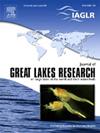Routine metabolism of larval and early juvenile lake whitefish (Coregonus clupeaformis) and cisco (C. artedi) at three temperatures
IF 2.4
3区 环境科学与生态学
Q3 ENVIRONMENTAL SCIENCES
引用次数: 0
Abstract
Lake whitefish (Coregonus clupeaformis) and cisco (C. artedi) are important contributors to Great Lakes ecosystems and to commercial and sport fisheries. Therefore, there is interest in understanding mechanisms that influence survival and growth, particularly recruitment declines beginning at early life stages. Routine metabolism is an important parameter in bioenergetic models to predict larval fish growth, yet there are few estimates of routine metabolic rate (RMR) for early life stage coregonines. We measured RMR of larval (<19 mm total length, TL) and early juvenile (19–29 mm TL) lake whitefish and cisco at three temperatures (8, 10, and 12 °C) to establish whether there are general differences between the two species or more specific differences in response to different temperatures. The metabolic rates of larval cisco were significantly higher than larval lake whitefish at 8 and 10 °C, but no species-specific differences in metabolic rates were observed at the early juvenile stage. RMR was positively related to temperature for both species at both life stages, although the magnitude of the temperature-dependent response was less pronounced for early juvenile fish than it was for smaller fish. With higher metabolic rates earlier in life compared to lake whitefish, larval cisco may exhibit higher growth rates if food resources are plentiful and may experience faster swimming speeds to search for prey and escape predators when resources are limited relative to lake whitefish.
湖白鱼(Coregonus clupeaformis)和cisco (C. artedi)在三种温度下幼虫和早期幼鱼的日常代谢
湖白鱼(Coregonus clupeaformis)和cisco (C. artedi)是五大湖生态系统以及商业和运动渔业的重要贡献者。因此,有兴趣了解影响生存和生长的机制,特别是在生命早期阶段开始的招募下降。常规代谢是预测幼鱼生长的生物能量模型中的一个重要参数,但很少有关于早期生活阶段coregonines的常规代谢率(RMR)的估计。在8°、10°和12°C三种温度下,我们测量了湖白鱼和cisco的幼鱼(总长度为19 mm)和早期幼鱼(总长度为19 - 29 mm)的RMR,以确定这两种鱼对不同温度的反应是否存在普遍差异或更具体的差异。在8°C和10°C条件下,思科鱼幼鱼的代谢率显著高于湖白鱼幼鱼,但幼鱼早期代谢率无物种特异性差异。两种鱼类在两个生命阶段的RMR都与温度呈正相关,尽管早期幼鱼的温度依赖性反应的幅度不如较小的鱼明显。与湖白鱼相比,在生命早期具有更高的代谢率,如果食物资源丰富,幼虫可能会表现出更高的生长速度,当资源有限时,幼虫可能会经历更快的游泳速度来寻找猎物和逃离捕食者。
本文章由计算机程序翻译,如有差异,请以英文原文为准。
求助全文
约1分钟内获得全文
求助全文
来源期刊

Journal of Great Lakes Research
生物-海洋与淡水生物学
CiteScore
5.10
自引率
13.60%
发文量
178
审稿时长
6 months
期刊介绍:
Published six times per year, the Journal of Great Lakes Research is multidisciplinary in its coverage, publishing manuscripts on a wide range of theoretical and applied topics in the natural science fields of biology, chemistry, physics, geology, as well as social sciences of the large lakes of the world and their watersheds. Large lakes generally are considered as those lakes which have a mean surface area of >500 km2 (see Herdendorf, C.E. 1982. Large lakes of the world. J. Great Lakes Res. 8:379-412, for examples), although smaller lakes may be considered, especially if they are very deep. We also welcome contributions on saline lakes and research on estuarine waters where the results have application to large lakes.
 求助内容:
求助内容: 应助结果提醒方式:
应助结果提醒方式:


